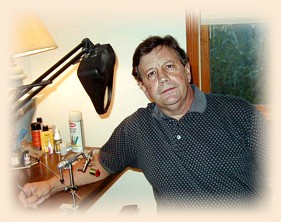There was a second, later version of the Cupsuptic found in Ray Bergman's Trout, shown here:

Ths is an advertisement from the Boston and Maine Railroad's "Fishing and Hunting" pamphlet
printed in 1895:

The Rangeley Region's prime industry was logging. Tourism was a distant second, with
trout fishing a small part of that. Logging was done in the Winter, and logs floated
out in the spring when the water was high enough. The dams were built to facilitate this,
and the railroad came to ship the timber out. The Boston and Maine Railroad realized that
they had these routes established, and it was not a big leap to put some passenger cars
on there and get some tourism going. Hence the promotion you see above. Here is a little
more information on rates:
 Over time, as the word got out about these huge brook trout, thousands came to the
region looking for that fantastic lunker. By the end of the 1800s 3000 visitors a year
were arriving, and upper dam was a zoo. Ripley Hitchcock states in an article for Outing
magazine written in 1886:
Over time, as the word got out about these huge brook trout, thousands came to the
region looking for that fantastic lunker. By the end of the 1800s 3000 visitors a year
were arriving, and upper dam was a zoo. Ripley Hitchcock states in an article for Outing
magazine written in 1886:
"With tender regard for the comfort of anglers, the Union Water-power Company of Lewiston,
which owns this property, has built easy stairways from the gate-house to the piers of the dam,
and at the ends of these piers are seats and foot-rests. In June or September each seat
will be occupied, there will be boats hovering about the pool below, and more boats
beyond the rapids and about the point a quarter of a mile away, where the little river flowing
from the dam enters the lower lake. The story is told of men who used to send their guides out
to sleep on the rocks or piers over night, that good place might be assured them for the
morning's fishing."
It is no wonder that fishermen began to fan out among the lakes, going north/west to Cupsuptic
and Parmachene, also called Parmacheene and Parmachenee. Cupsuptic lake appears to
be one of the few bodies of water in the entire region with only one name. Even Bemis
stream was called Bema and Beamis. I'm not quite sure why it was neccessary to call every
single body of water in the area by two or more names, but that certainly has been the custom.
I've found this description of Cupsuptic lake from the
same Boston and Maine Railroad publication:
"Cupsuptic Lake is by many persons thought to be the most beautiful of the chain. It was in this water
that Senator Frye landed a trout weighing upwards ten pounds, -said to be the largest ever taken on
a fly. Upon the surface of Cupsuptic numerous beautiful islands are dotted, and the shores
are indented in the most picturesque way by coves and miature bays, overshadowed by the forest
growth that comes down to the water's edge. From the shores the lands mount abruptly
upwards on every side until they encircle the lake with a broken crest of hills, fair to
look upon, and holding the water sheet as the cup holds its contents."
The large brook trout are gone from the rivers, lakes and ponds that make up the Rangeleys.
To this day it is a quality fishery however, with good size brookies and salmon in
abundance. In the next article we'll have a look at some factors that may have resulted
in the brook trout's decline in both this region and the Adirondacks. In the meantime,
here are the recipes for both versions of the Cupsuptic wet fly.
Cupsuptic, original
Tail: Blue fiber and peacock.
Body: Silver tinsel.
Hackle: Scarlet palmer.
Wing: Brown turkey, guinea over.
Cupsuptic, Bergman
Tail: Yellow hackle.
Body: Silver tinsel
Hackle: Crimson palmer.
Wing: Narrow guinea over brown turkey
Credits: Fishing and Hunting by
the Boston and Maine Railroad Passenger Department;
Flies by J. Edson Leonard;
Trout by Ray Bergman;
Carrie Stevens by Graydon R. Hilyard;
Outing Volume Vlll Issue 3 June 1886 "Trout Fishing
In Maine" by Ripley Hitchcock; ~ EA
About Eric:
 Eric lives in Delaware, Ohio and fishes for brown trout in
the Mad River, a beautiful spring creek. More of his flies
are on display here:
Traditionalflies.com -- Classic salmon and
trout flies of Europe and the Americas.
Eric lives in Delaware, Ohio and fishes for brown trout in
the Mad River, a beautiful spring creek. More of his flies
are on display here:
Traditionalflies.com -- Classic salmon and
trout flies of Europe and the Americas.
|





 Eric lives in Delaware, Ohio and fishes for brown trout in
the Mad River, a beautiful spring creek. More of his flies
are on display here:
Traditionalflies.com -- Classic salmon and
trout flies of Europe and the Americas.
Eric lives in Delaware, Ohio and fishes for brown trout in
the Mad River, a beautiful spring creek. More of his flies
are on display here:
Traditionalflies.com -- Classic salmon and
trout flies of Europe and the Americas.